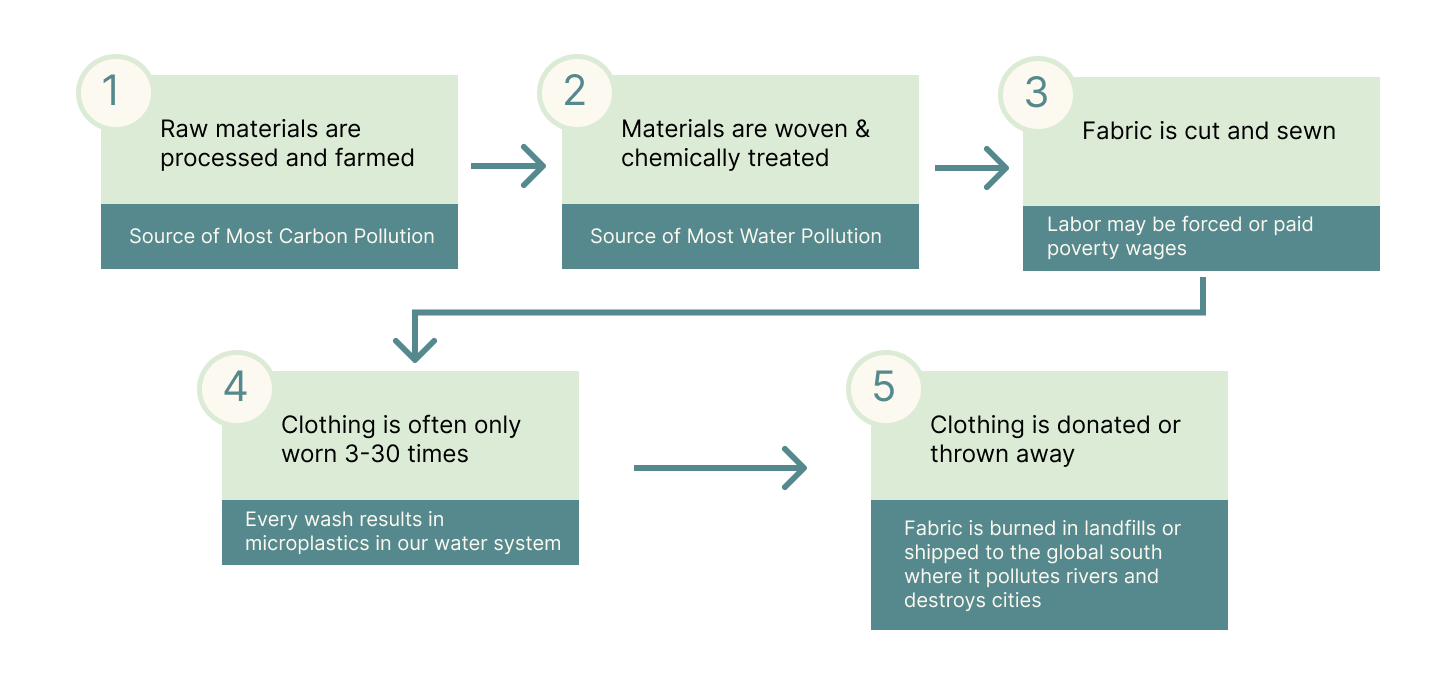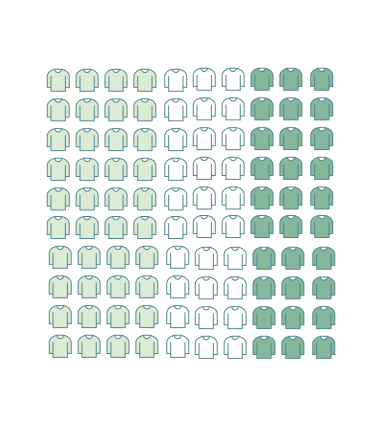Canditch
Canditch is a fashion product that searches the internet to find users sustainable replicas of less-ethical clothing to promote an easy switch to a sustainable lifestyle.
My role in this project was primarily in the research and the app design. I also sketched out the design for the plugin and wrote the interactive story.
Tools
Figma, Illustrator
Skills
UX/UI, Design Research, Wireframing
Duration
8-week design research & ideation
Team
Farrah Nobles, Trent Huffaker & Angelina Lodes
Overview
Everyone participates in the global fashion trade. Wether used to express ourselves or simply stay warm, consumers are purchasing nearly $2 trillion worth of clothing yearly. The production of clothing contributes to 10% of the global carbon production and 20% of water pollution. After these clothes are used they typically end up in landfills in the global south.
Canditch was created to educate consumers on their fashion waste and provide a resource for purchasing sustainable fashion.
Objective
Our goal is to decrease consumer spending and encourage consumers to purchase sustainable fashion through education and technology.
What are the biggest challenges for a consumer who wants to shop sustainably?
Greenwashing
Consumers that want to make sustainable choices may be conned by greenwashing initiatives. Currently many brands use the words “eco” “green” and “sustainable” without providing any proof, as there are no laws that can stop them.
Lack of Education
Many people know that fast fashion is bad, but don’t know why. Most consumers are not aware of how synthetic fabrics are made or their prevalence in their wardrobe. Nor, are they aware of what happens to their clothes when they get dropped off at most thrift centers.
Resources are Slim
For consumers that want to buy fashion ethically, there are currently only one or two resources for finding ethical brands, and only one website that rates brands in a user friendly way.
No Transparency
Many major name brands are not proud of their supply lines, and therefore publish almost nothing about their process. One can only assume if a brand is not publish-ing information on their supply lines it’s due to their unethical practices. Only smaller brands that are built on the idea of transparency have full-proof ethical supply lines.
Habitual Shopping
The consumers we are targeting are used to purchasing clothes on a regular basis, at least once a month. Purchasing clothes on this scale will never be sustainable, unless the clothes are thrifted or re-purposed materials. Habitual shopping also results in a constant flood of discarded clothing.
What are the main components of fast fashion?
Water Pollution
Toxic chemicals have
poisoned rivers, destroying people’s way of life
Dying, Bleaching and
processing of fabric results in 20% of overall water pollution in the world
Waste
Clothing unsold in thrift shops ends up in landfills in the global south
Synthetic fabric results in fabric that cannot be re-used or recycled
Labor
Unethical labor practices results in forced labor
Garment workers in America are currently not paid the minimum wage
Fabric Choices
number one cause of micro-plastics in our drinking water
Synthetic fabrics are not resilient and do not last as long as traditional fabrics.
The majority of synthetic fabrics are made of oil and petroleum
The Toxic Cycle

How can consumers change their behavior?
Ethical Brands
Shopping from sustainable brands means knowing a brand’s entire production line from farm to shopping center. They never use plastic based synthetic fibers and are certified through a number of organizations that prove they are telling the truth.
Buying Thrift
Since almost half of clothes donated end up in the garbage, buying thrift keeps clothes out of landfills and is a cheaper and more sustainable option than buying new.
Reusing Fabric
Most clothing can be modified to fit into new trends rather than buying whatever the newest style is. Learning how sew and modifying clothing can help curb the instinct to always buy new.
Recycling Fabric
Fabric recycling programs and circular economies are the future of sustainability. Some brands offer incentive to give them your old clothing that will be recycled and turned into new clothing. There are also fabric recycling factories near major cities, this is a better option than donating when items are unwearable.
Problem Statement
The fashion industry is polluting the world in a number of ways and many people are not aware how harmful this industry has become. Those who are aware of the blanket issues related to fast fashion may not know how to take action, especially when resources are so limited.
Target Audience
Our target audience consists of two main demographics: Women 25-34 and Women 45-54. Through are research we found that the younger audience spends the majority of their time online shopping while the older audience is most likely to spend the most amount of money on clothing.
Survey Results
To confirm our research we surveyed our audience. Our findings made us realize our product would need to work both at in-person locations and in online-retail. The amount of people that do not consider how their clothing is made means there is an audience to be educated, but also that there are many people who would enjoy knowing more about how their clothing is made and how to purchase ethically.

50% purchase clothing at least once a month or more

40% Prefer F2F retail
30% Prefer F2F thrift
30% Prefer online retail

49% Do NOT consider how their clothing was made as a purchasing factor
Who is in the sustainable fashion field currently?
Good On You
Good on you provides a comprehensive library of brand ratings. They have done the work to establish brand ratings for both major brands and smaller ethical brands. Within their library brands are rated on a system of 1-5 using smiley faces. Each brand is rated in three categories; people, animals and the planet.
While Good on You provides the ratings and focus on finding sustainable brands to present to consumers, the user journey of attempting to find an item is complicated and relies on the user clicking through brands, being re-directed to the brands website to browse and then cycling through again, until what the user is searching for is found.
Fashion Sustainability Index
The fashion sustainability index is not so much a product, but rather a brochure that presents relevant statistics related to fast fashion. The index presents data from a variety of large brands to show how transparent their supply lines are. Rather than focusing on consumer choice, the fashion sustainability index comes from Fashion Revolution. The goal of the Index is to present information to consumers to insight global change, specifically to laws regarding clothing production and waste.
How can we both educate our audience on sustainability in fashion and provide an incentivized resource to help them take action?
The Solution
The Canditch system of products both provides an education on sustainable fashion and a resource for users to find clothing items that are good for both people and the planet. Three different platforms are utilized to achieve these goals.
First, an interactive web experience acts as a user’s introduction to sustainable fashion. Second, a web-plugin acts as a filter inside of google shopping to let users find new options that would not normally be recommended to them. Third, an app uses photo recognition technology to mimic what the plug-in does, but in real life.
Final Design
Our team created a short video to introduce and summarize the use of each of our products.
Interactive Web Story
The interactive web experience to walks consumers through the issues in the fashion industry.
The Life of a Shirt
In this path we mapped out how a shirt is made, in which the user explores the factories and workers that have all been a part of creating their shirt. We wanted to keep the brand voice light, yet informative.
At the end of the story you are give the option to follow other story paths.
Download
At the end of the top of this website you are given the option to download our web-plugin.
Browser Plug-In
The web-plugin is a browser ad-on compatible with chrome-based browsers. We decided this would be the easiest way for consumers to integrate sustainable shopping into their usual browsing.
Activation
The plugin can be enabled through the plugin window. This will result in dots appearing over different clothing items in the selected picture.
The plugin will also identify the brand associated with the item and show you the brands current good on you rating.
Search
Once you select a dot from the picture, the plugin will populate similar items using neural networks that search through both sustainable brands and every thrift brand available on the internet.
We wanted our design to blend into the google interface while still representing our brand.
Profile
You can access your Canditch profile though the plugin.
When you purchase items through the plug-in your Canditch sustainability rating increases.
Your profile shows both items purchased, saved and scanned images from the app, if it has been downloaded.
Mobile App
Through our research we realized users tend to prioritize in-person shopping over online shopping, so we wanted to create an app that could work for Canditch users in stores.
Walkthrough
The Canditch app presents new users with a quick walk-through to highlight the key features within the app.
Scan Camera
Once inside, it is super simple to utilize the scan camera to capture images from the street or in-store of other outfits.
Once scanned, the app works the same as the plugin, allowing users to find similar items that are sustainable.
The app also includes the Candid Guide, which is a simple guide for searching sustainable fabrics and brands on-the-go.
All items purchased, saved and scanned can be found on the profile page.
Candid Guide
The app also includes the Candid Guide, which is a simple guide for searching sustainable fabrics and brands on-the-go.
All items purchased, saved and scanned can be found on the profile page.
Synced Profile
All items purchased, saved and scanned can be found on the profile page. As well as the user’s sustainability rating.
What I learned:
This project was the most fun I have ever had designing and coming up with ideas. I had a great team, I made sure each person got to do what they love to do the most and I worked really hard to make sure everyone’s ideas were being heard. This taught me exactly what working in a group should feel like, as everyone brought equal amounts of passion. I also learned a lot about fast fashion and the complications of prototyping overlays in Figma.
What I would do differently:
Overall I really wish more time could’ve been spent on the story. The story is very much a question-answer sort of experience and If we had been able to spend more time on it, it would have been much more interactive. We wanted to make it feel more like a mini-game, but between the three different executions, there was just too much to do in 8-weeks to make the story feel as polished as I would’ve liked.
